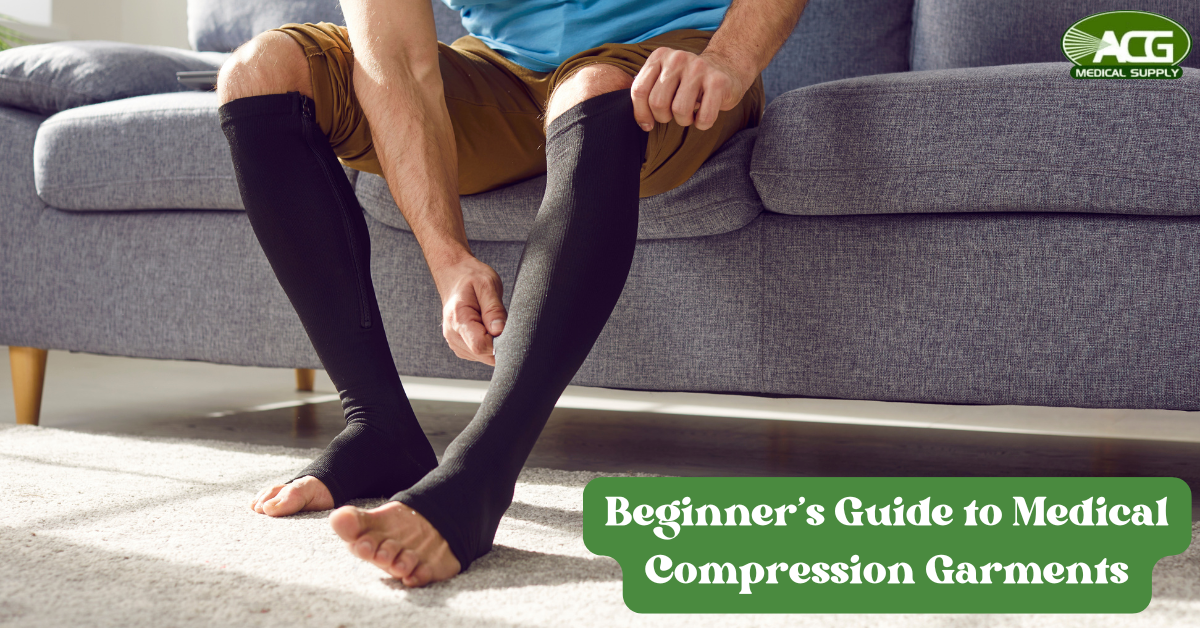There’s no loud advertisement or dramatic before-and-after story behind compression garments. In fact, most people only hear about compression garments when they need them, after surgery, during treatment, or through someone quietly managing swelling or circulation issues.
And that’s part of their value. They don’t draw attention. They do their job.
Unlike many wearable health aids, compression isn’t about high-tech sensors or trends. It’s about consistent, carefully applied pressure that supports the body’s natural circulation, helps reduce swelling, and adds stability where needed.
At ACG Medical Supply, these garments aren’t treated as just another product. They’re part of a broader focus on practical solutions that help people live and move better, day by day.
Understanding Compression Garments
The purpose of compression garments is straightforward: apply controlled pressure to help with circulation and reduce swelling.
Common types you will come across while researching include:
- Sleeves are for arms
- Socks and compression stockings are for legs
- Wraps and bodysuits are for torso support
Doctors often recommend these for people who are recovering from a major abdominal surgery, dealing with varicose veins, or are suffering from chronic swelling. In cases like lymphedema support, they’re absolutely necessary.
And sometimes, people use them simply because standing for 10 hours a day takes a toll on their legs.
Who Are They For?
You don’t need to have a medical condition to benefit from compression garments. People who turn to medical compression garments come from all kinds of backgrounds:
- People who work in a warehouse, nurses, and other people who are on their feet all day
- People who run or go to the gym, as they most probably have sore or inflamed muscles
- People who have had a recent surgery
- Frequent travelers dealing with circulation issues
- Those managing lymphoedema treatment for the legs
And of course, those under medical care for venous insufficiency or DVT risk rely on these garments long-term.
Types of Compression Garments
Not all compression garments are the same. There are specific garments made to support specific areas and needs.
You’ll see compression stockings used mostly on the legs, ankle up to the thigh. They’re not fancy, but they help more than you’d expect. If your calves tend to swell up by the end of the day, stockings can really take the edge off. Then there are arm compression sleeves, they are less talked about but they are just as useful, mostly for people who are healing from surgery or people who are managing lymphedema, post-surgery compression garments also help in recovery after surgery, for example, surgical bras or full-body suits, offer that extra bit of support the body needs to heal without any complications while helping keep fluid buildup in check.
Choosing the Right Compression Level
There are several levels of compression a garment can provide. Fair warning, compression levels are measured in mmHg, which sounds like medical jargon, but it really only means how much pressure the garment puts on your body.
8–15 mmHg (Mild)
Light support. This compression level is ideal for tired legs, mild swelling. No medical reason is needed for this level of compression.
15–20 mmHg (Moderate)
A bit stronger. This level of compression is great if you are pregnant, stand a lot at work, or have noticed early signs of varicose veins. This level also can be used without a prescription.
20–30 mmHg (Firm)
More structured support. This level is supposed to be used after suffering through a surgery or for issues like mild lymphedema. Check with a doctor before use.
30–40 mmHg (Extra Firm)
Medical-grade pressure. This level of compression is usually prescribed for serious vein or lymph issues. Use extra firm compression only when a doctor prescribes it.
Tips for Care and Comfort
Here are a few small changes and habits that can make getting used to wearing medical compression garments every day a lot easier:
- Wear them right after waking up; that’s when the swelling is at its lowest
- Use gloves, they help grip the fabric and avoid damage while pulling them on
- Wash regularly, either by hand or using cold cycles. Air drying preserves the elastic fibers
- Replace them every 3 to 6 months or as soon as they feel loose or stretched
And here’s a detail that is really important to follow: if something feels off—too tight, too itchy, or just wrong—it’s okay to stop using it and get a refit. Compression should support you, not restrict you.
Conclusion
Compression garments are not really a flashy purchase when it comes to garments, but for those who need them, they’re absolutely life-changing. They do their job quietly and help people feel stronger, move more easily, and recover faster.
And with providers like ACG Medical Supply, finding the right fit is just a few clicks away.
FAQs
Q1: Do I need a prescription?
Not for all garments. Light and moderate pressure levels can often be bought over the counter.
Q2: Can I sleep in them?
Unless your doctor says so, it’s better to remove them at night. Body position changes while lying down.
Q3: How long should I wear compression garments?
Preferably all day, you should put them on first thing in the morning and remove them before going to bed at night, unless told otherwise.
Q4: Are they hard to put on?
They can be, especially higher-pressure ones. But gloves or a simple plastic aid can help a lot.
Q5: Are compression garments only for older adults?
No. People of all ages use them for work, travel, recovery, and comfort.

